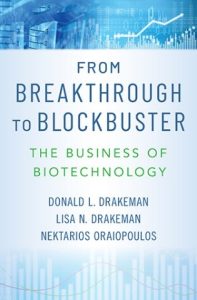The biotechnology industry is highly complex and encompasses a wide range of enterprises, including monoclonal antibody therapeutics research and development. The new book ‘From Breakthrough to Blockbuster: The Business of Biotechnology’ (Oxford University Press, 2022) written by experts in the field, Donald L. Drakeman, Lisa N. Drakeman, and Nektarios Oraiopoulos, provides an insightful view into the inner workings of the industry and the characteristics of biotechnology firms vs those of traditional pharmaceutical companies. The authors provide thoughtful and thorough analysis of the biotech ecosystem, which includes academic researchers, investors and other funders, contract research and manufacturing organizations, and corporate partners.
The book begins with discussion of the scientific advances, particularly recombinant protein and monoclonal antibody technologies, on which the biotechnology industry was founded, as well as the overall process of drug development, which is lengthy and expensive. A key point is that most biotech firms do not have the internal expertise to perform all the required work, which includes manufacturing and clinical trials of the drugs they wish to market. Therefore, access to the biotech ecosystem, and the ability to pay for external services, is critical for success.
The authors then describe sources for the intellectual property on which biotech firms are founded and the various ways these organizations can raise funds, typically starting with venture capital, then potentially an initial public offering. Biotech firms also benefit from alliances with pharmaceutical companies, which can provide validation of their work as well as funding. While discussing aspects of the dealmaking required for partnering and alliances, the authors make a key point – neither the biotech firm nor the pharmaceutical company can predict the outcome due to the substantial number of variables and the complexity of the drug development process, and the historical high rate of failure.
In addition to ideas and funding, the biotech industry must have entrepreneurs who serve as founders and managers. The authors outline the general characteristics of biotech entrepreneurs, which include being adept at creative problem solving, having a high level of achievement motivation, being comfortable taking risks and doing new things, and having a high tolerance for rejection and failure. A substantial amount of the entrepreneur’s time will be spent on fund-raising, so they must create a compelling story about what the firm is doing, why this is important, and their plans for the future to pitch to venture capitalists. In making alliances, the entrepreneur must have a clear understanding of the forces driving decisions at the prospective partner company.
The penultimate chapter focuses on the question of who has developed the most innovative drugs – the biotech industry or traditional pharmaceutical companies. The authors make a strong case that the biotech industry is better at this process because its decision-making process is fundamentally different. The biotech industry is a decentralized system composed of thousands of firms that generate multiple projects and run parallel searches under highly competitive conditions. Investors looking for timely exits can place substantial pressure on company managers to perform “killer experiments” designed to disprove key hypotheses, and thereby quickly distinguish between projects that should proceed vs those that should be terminated. In contrast, traditional pharmaceutical firms tend to have centralized decision-making processes that lead to fewer projects and slower decisions to terminate projects.
In the final chapter, the authors discuss the future of the biopharmaceutical industry, which is critically dependent on government and insurers to pay for the drugs once they are approved for marketing. The biotech industry must offer value sufficient to attract investors, but the price of the resulting products cannot place an overwhelming burden on healthcare systems. Striking a balance between these opposing forces is critical to maintaining a robust biotech industry capable of producing new advances in medicine.
Throughout the book, the authors provide data that support their points in numerous figures and tables. Valuable references are provided in the copious footnotes, which also provide amusing asides (for example, a quote from The Pirates of Penzance, discussion of the origin of biotech company names, a reference to a possible link between juvenile delinquency and subsequent entrepreneurship). In recommending ‘From Breakthrough to Blockbuster: The Business of Biotechnology’, we can only agree with the authors’ summary:
“…this book will be a useful resource for management students and scholars, biomedical scientists, venture capitalists and other investors, entrepreneurs, healthcare policy makers, and all others interested in how new medicines come into being, why the process is so breathtakingly expensive, and how small entrepreneurial ventures can compete in one of the world’s most expensive and heavily regulated industries. Beyond that, the story of how a vast collection of inexperienced, underfunded, and unprofitable small companies have created more life-changing new medicines for less money than the largest global pharmaceutical firms is well worth reading.”


